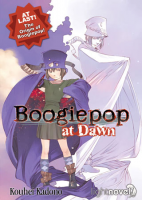 Author: Kouhei Kadono
Author: Kouhei Kadono
Illustrator: Kouji Ogata
Translator: Andrew Cunningham
U.S. publisher: Seven Seas
ISBN: 9781934876060
Released: August 2008
Original release: 1999
Technically, Boogiepop at Dawn is the sixth volume in Kouhei Kadono’s series of Boogiepop light novels illustrated by Kouji Ogata, however it serves as a prequel to the entire work. Seven Seas jumped to releasing Boogiepop at Dawn after publishing the first three Boogiepop novels in English—Boogiepop and Others and Boogiepop Returns: VS Imaginator, Part 1 and Part 2. It was a decision that made sense: the entire series wasn’t able to be translated, Boogiepop at Dawn ties in directly with the early novels, and the volume was partially the basis for the Boogiepop Phantom anime. Boogiepop at Dawn was originally published in Japan in 1999 while Andrew Cunningham’s English translation was released by Seven Seas in 2008 (two years after the first three books). I discovered the Boogiepop franchise late, after the novels and manga available in English had already gone out of print, but I have still been thoroughly enjoying the series and looked forward to reading Boogiepop at Dawn
As an agent working for the secretive Towa Organization, Scarecrow is responsible for finding other humans who, like him, have extraordinary psychic and physical abilities and strengths. The Towa Organization is very interested in these remarkable people; by controlling them it hopes to control the course of human evolution. Scarecrow’s search is made easier by the fact that he poses as Kuroda Shinpei, a private detective; he is able to continue his primary investigation while working more mundane cases. Scarecrow meets Kirima Nagi, a young woman who has been hospitalized with an undiagnosed but painful condition, while searching for evidence against another Towa agent whose loyalty has been called into question. Nagi has the potential to become one of those exceptional, highly-evolved people he is searching for, but instead of reporting her to the Towa Organization, Scarecrow decides to go against his orders, saving her life by risking his own and triggering a sequence of events that will leave multiple people dead.
 Although Boogiepop at Dawn is a prequel, it really is intended to be read by those who are already familiar with Boogiepop in general and with the first few volumes of the series specifically. But for those readers who are, Boogiepop at Dawn is spectacular and a very satisfying addition. Ostensibly the volume is the origin story of Boogipeop—a supernatural entity in conflict with the Towa Organization who is also keeping watch over the super-evolved humans, destroying them when necessary—and to a small extent it is. But Boogiepop actually makes very few appearances in the volume. However, Boogiepop at Dawn does provide an extensive background for another of the series’ primary characters, Nagi, and explains the purpose of the Towa Organization. Many of the other protagonists and antagonists from the earlier Boogiepop novels make a showing as well, which ties everything together very nicely. I was particularly pleased to learn more about Nagi’s father, Kirima Seiichi, an author of peculiar importance to the series whose story hasn’t been fully revealed until now.
Although Boogiepop at Dawn is a prequel, it really is intended to be read by those who are already familiar with Boogiepop in general and with the first few volumes of the series specifically. But for those readers who are, Boogiepop at Dawn is spectacular and a very satisfying addition. Ostensibly the volume is the origin story of Boogipeop—a supernatural entity in conflict with the Towa Organization who is also keeping watch over the super-evolved humans, destroying them when necessary—and to a small extent it is. But Boogiepop actually makes very few appearances in the volume. However, Boogiepop at Dawn does provide an extensive background for another of the series’ primary characters, Nagi, and explains the purpose of the Towa Organization. Many of the other protagonists and antagonists from the earlier Boogiepop novels make a showing as well, which ties everything together very nicely. I was particularly pleased to learn more about Nagi’s father, Kirima Seiichi, an author of peculiar importance to the series whose story hasn’t been fully revealed until now.
Boogiepop at Dawn is a collection of four closely connected narratives with an additional framing story that bookends the volume. Most of the stories focus on Nagi, either directly or tangentially. Much like the other Boogiepop novels, Boogiepop at Dawn employs elements from a number of different genres, but it may safely be called speculative fiction as a whole. All melded together in the volume are bits of mystery and detective work, horror, action and martial arts, the supernatural, and science fiction. Boogiepop at Dawn is engaging and at times chillingly dark with heavy psychological components. The individual stories are seen from different perspectives, at various points following Scarecrow, Seiichi, a serial murderer, and an assassin. Boogiepop is mostly a presence in the background, but an important one nonetheless. Boogiepop at Dawn is also similar to the earlier volumes of the series in that it does not adhere to a strictly chronological structure, but it’s fascinating to seen the beginnings of the plot threads that will become so entangled in the other novels.

I remember trying to watch the anime adaptation of this and giving up after four episodes because it was so frustratingly hard to follow.
I haven’t seen any of Boogiepop Phantom yet (or watched the live-action film, or read the manga) but I do plan to since I enjoyed the novels so much. Maybe the anime will be easier to follow for someone who is already familiar with some of the story.
It’s been a while since I saw it but I remember the four episodes where the same story told from a different perspective slightly along with a really murky art style.